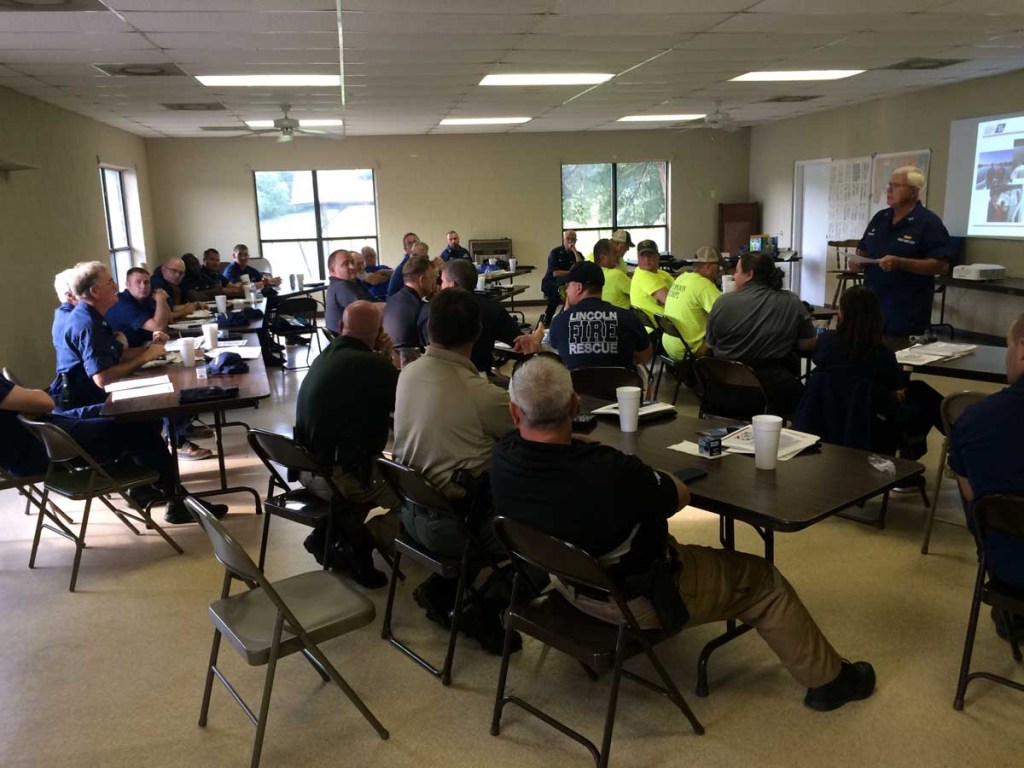38 graduate U.S. Coast Guard Auxiliary Fleet Academy
Published 6:46 pm Thursday, August 16, 2018

- The intense classroom workshop had eight teams working through seven advanced navigation problems with over 151 questions relating to charting, courses, set and drift, and search and rescue. Photo courtesy of USCGA
The 2018 Coast Guard Auxiliary Fleet Academy at Logan Martin achieved their expected goals and was an overwhelming success. The event was held on August 3-5 with classroom workshops at the New London Fire Department and staged on the water command center at the Birmingham Sailing Club.
The academy graduated 38 officers, crew, and coxswains representing seven different agencies using 10 water and one air asset. The academy included Officers, Coxswains, and Crew from St. Clair County Sheriff’s Office, Alabama Law Enforcement Agency (ALEA), New London Fire Department, Lincoln Rescue, Pell City Police Department, and the Coast Guard Auxiliary.
This was the largest joint marine training exercise in the region and the beginning of a new Coast Guard Auxiliary water response training, support, and platform model that will make the lake community safer and the marine first responders more effective.
The event featured eight Coast Guard active duty from Coast Guard Station Dauphin Island, Coast Guard Shore Side Detachment Demopolis, and Coast Guard Sector New Orleans acting as trainers and proctors. This included the Coast Guard Order Issuing Authority (OIA) officers who issue the Auxiliary orders on Logan Martin as well as the Coast Guard Operations Training Officer (OTO) training officer who is in charge of training the Auxiliary on Logan Martin. This allowed the event to deliver the highest quality of training as well as the most advanced on the water scenarios.
With the cooperation and participation of every attending agency, they achieved the goals of the event and much more. The academy brought together the primary local marine first responders to showcase their resources and skills.. Each agency now has a better understanding of the capabilities and roles of the other partner agencies. The officers, crews, and coxswains worked through advanced navigation scenarios using the latest tools which will enable the agencies to locate and find targets on the water more efficiently. The inter-agency crews were tested and evaluated on the water against the Coast Guard seamanship skills for professional mariners. The joint agency event highlighted the unique challenges of the local operating area and developed a model for working together in several extremely challenging scenarios.
Using the new Auxiliary step-by-step navigation worksheets, the navigation exercises were led by the active duty Coast Guard. The advanced navigation featured Coast Guard training charts and local charts using the latest navigation apps and U-plot-it tools. The intense classroom workshop had eight teams working through seven advanced navigation problems with over 151 questions relating to charting, courses, set and drift, and search and rescue.
The navigation session took the officers, crews, and coxswains further and deeper than any other one-day training program. All of the attendees completed the exercises with new skills on how to more efficiently locate things on charts as well as electronically which will reduce response times.
The participants were split into inter-agency teams to go on the water to complete in the Auxiliary’s Amazing Race. This gamified boating skills test featured five waypoints that had to be located and charted during the navigation exercises. The boats navigated to the waypoints with the Coast Guard active duty on the boat acting as proctors.
At the waypoints, the crews had to complete an advanced boating skills test, but to make it even more challenging some of the components of the tests were surprise elements that were only revealed on site by the proctors in order to check the team’s response to the unexpected.
The advanced activities inspired by real-life active duty training included 4 point touch, man overboard, 180 anchoring, parallel search, and close quarters dock and spring, and coxswain down. The proctors then reviewed and scored the performance against the Coast Guard’s seamanship best practices. The Coast Guard prides itself on the standardization of the on the water skills in order to insure inter-changeable resources and interoperability.
The crews witnessed the importance of standardization of training, observed some new boat handling skills, and used some new boat tools. These 3 accomplishments will keep the officers safer while on duty and will also make it easier to work together in the future.
The joint command then brought the departments on the water on their own boats and aircraft to execute three flights of large scale scenarios. The scenarios were managed by a radio guard, which was being monitored by Coast Guard Sector Mobile and established a communication model to work with over four different frequency channels. The scenarios featured extinguishing a shore fire from the water, a water rescue, BUI protocols, search and rescue with flares, medical emergencies, air search, stern and side towing with docking.
Each boat carried a Coast Guard proctor to guide, evaluate, and score the performance. All of the scenarios were completed successfully, but also highlighted some opportunities where additional training would result in even better results. The joint operation established an operation model, a communication plan, and an activity blueprint for future real-life operations that will allow each department to work more efficiently together.
“This event was successful because of the enthusiastic support of each participating agency. The expertise of the Coast Guard active duty enhanced the event to highest possible quality. And the support of the local community providing accommodations, catering, ballroom dinner, shirts, and the venues allowed everyone to perform at the highest possible levels,” said Trent Richardson. “With the right funding, we look forward to making this an annual event.”
The Fleet Academy shows how the Coast Guard Auxiliary can be a critical local partner to provide support, training, and platforms for the marine fire, police, and rescue agencies.



